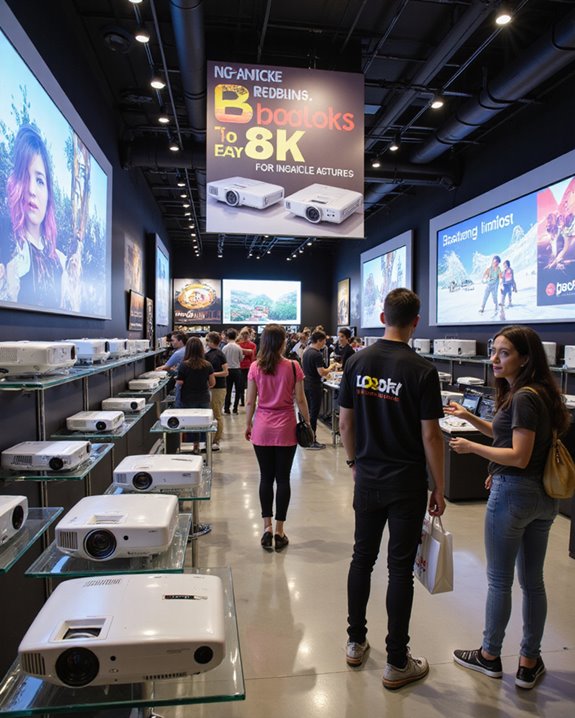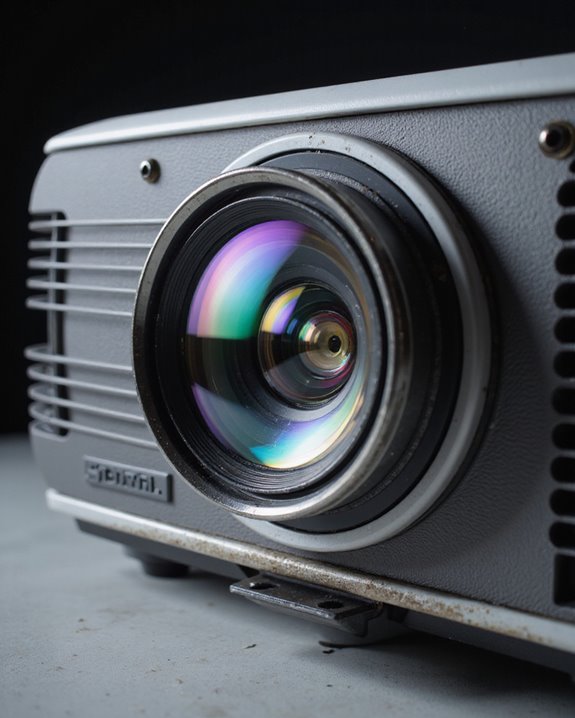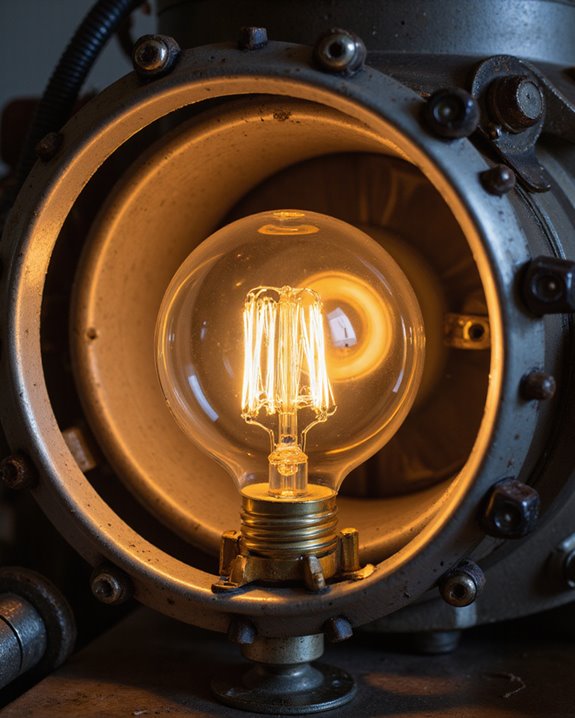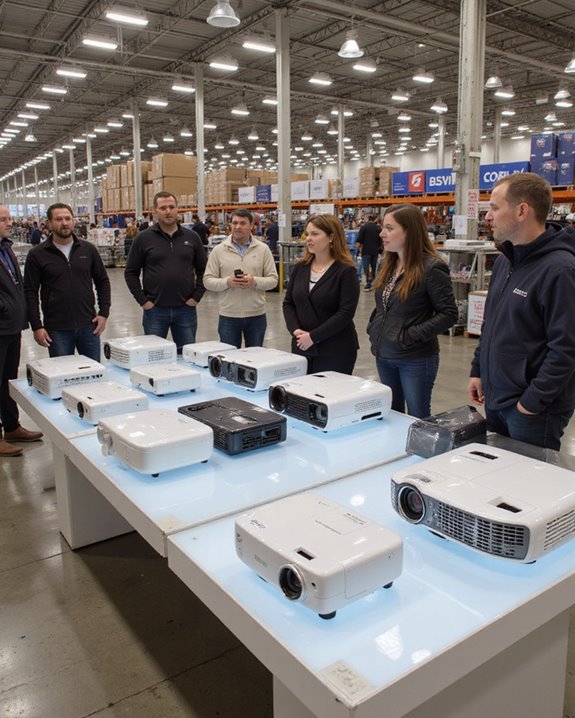Several modern smartphones now feature built-in projectors for home theater use. The TANK 2 leads the market with its laser projector system, 108MP camera, and 15,500mAh battery. The Oukitel WP100 Titan offers facial recognition alongside projection capabilities. These devices typically provide resolutions up to 480×800 pixels and brightness levels between 15-100 lumens, suitable for basic video viewing. While built-in projectors offer convenience, their performance depends heavily on room lighting and viewing conditions. Understanding proper setup techniques guarantees ideal projection quality.
Key Takeaways
- TANK 2 smartphone features a laser projector with 108MP camera and 15,500mAh battery, making it suitable for extended home theater viewing.
- Oukitel WP100 Titan combines a built-in projector with facial recognition and rugged design for versatile home entertainment use.
- Upcoming 2025 models will offer 70-lumen micro projectors with MT8788 processors and 8GB RAM for enhanced home theater experience.
- Samsung Galaxy Beam provides 15 ANSI lumens brightness with WVGA resolution, though performance is limited in well-lit environments.
- Blackview Max 1 includes manual focus adjustment for clearer viewing and can project images up to 150 inches at 2.5 meters.
Understanding Phone Projector Technology
The technology behind phone projectors represents a significant advancement in mobile display capabilities, combining miniaturized projection systems with everyday smartphone functionality. These compact projectors utilize either LED or laser diodes as light sources, which help minimize heat production and power consumption while maintaining brightness. Some devices like the Galaxy Beam 2 featured higher resolutions and brighter displays compared to their predecessors.
At the heart of these systems are micro mirror arrays, tiny mechanical mirrors that direct light to create projected images. The technology typically achieves resolutions of 480×800 pixels, suitable for basic video playback and presentations. Modern designs incorporate specialized protective lenses to shield the delicate optical components from damage and debris.
Recent improvements in laser diode efficiency have enhanced projection brightness and duration, while advances in cooling systems allow these projectors to operate effectively within the confined space of a smartphone body. Additionally, miniaturized optical components enable seamless integration of projection technology into compact devices without sacrificing image quality.
Top Phones With Built-In Projectors
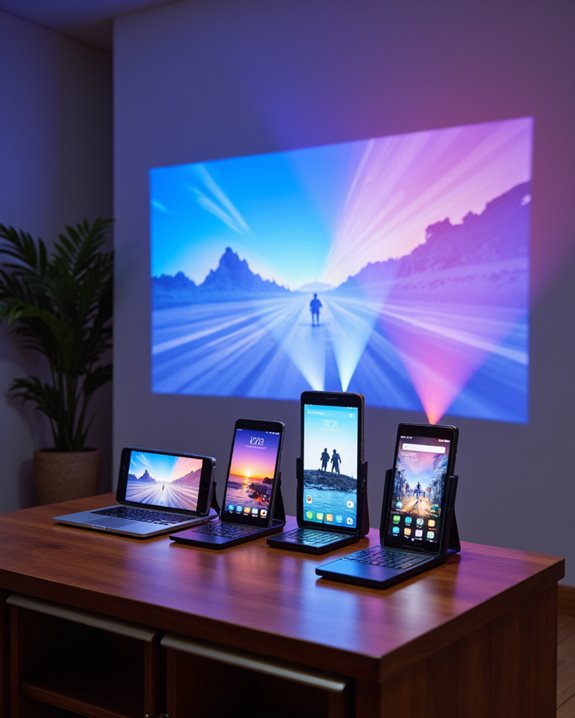
Leading the market for smartphones with integrated projectors, several innovative models combine projection capabilities with robust features and durability. The TANK 2 stands out with its laser projector and 108MP camera, making it suitable for both mobile gaming and high-quality photography. Its 15,500mAh battery guarantees extended projection time. The TANK 2’s impressive IP68 standard protection ensures reliable performance even in challenging outdoor environments where dust and water exposure are common. Additionally, its compact design enhances portability for on-the-go entertainment and presentations.
The Oukitel WP100 Titan offers advanced features including facial recognition and dedicated projector control buttons. Its ultra-rugged design makes it ideal for outdoor use, while the built-in projector allows for impromptu presentations or entertainment viewing.
Emerging 2025 models feature micro projectors with 70 lumens brightness, powered by the MT8788 Octa Core processor. These devices typically include 8GB RAM and 256GB storage, supporting smooth multimedia playback and extensive media storage capabilities.
Brightness and Display Performance
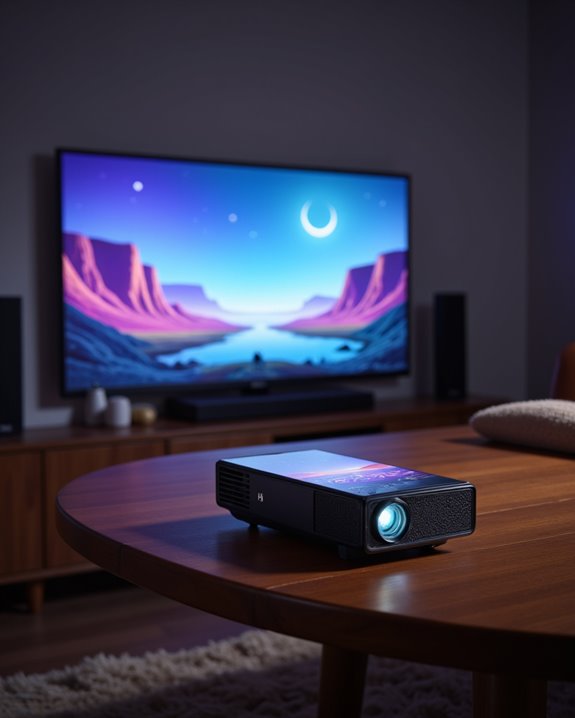
How effectively a phone’s built-in projector performs depends primarily on its brightness levels, measured in lumens. Modern projector phones have made considerable advances, with the Tank 3 Pro offering 100 lumens compared to earlier models like the Samsung Galaxy Beam‘s 15 ANSI lumens. Higher brightness allows for better color calibration and improved contrast ratio in less-than-ideal lighting conditions. The Tank 3 Pro’s manual focus adjustment enables precise image calibration for optimal viewing clarity. Additionally, the brightness range of these devices varies significantly, affecting their suitability for different environments. Display resolution also plays a vital role in image quality. The Blackview Max 1 leads with 720p resolution (1280 x 720), delivering sharper images than competitors. Most projector phones perform best in dark environments, with image quality degrading notably when ambient light exceeds 5-10 lux. For ideal viewing, these devices typically require a throw distance of 1-2.5 meters and can display images ranging from 40″ to 150″ in size.
Setting Up Your Phone Projector System
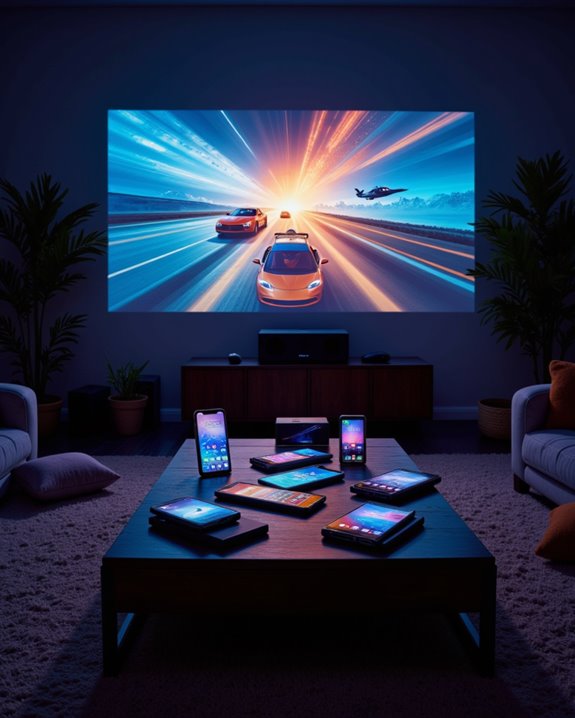
Successfully setting up a phone projector system requires careful attention to both hardware compatibility and physical positioning. Users must first identify available connection ports on both devices and select appropriate adapters or cables for seamless connectivity. Power considerations are critical, as USB connections may require external power sources for extended use. Wireless streaming options like Miracast or AirPlay provide alternative setup methods when direct connections aren’t practical.
Proper physical placement is vital for peak performance. Using tripod mounting systems helps stabilize the projection setup while allowing for easy adjustment of viewing angles. The setup area should have minimal ambient light, and the projection surface should be flat and light-colored. Users need to configure their phone’s display settings, including brightness and orientation, to match the projection requirements. Audio considerations are equally important, with options ranging from built-in speakers to external sound systems connected via Bluetooth or auxiliary cables.
Battery Life and Power Management
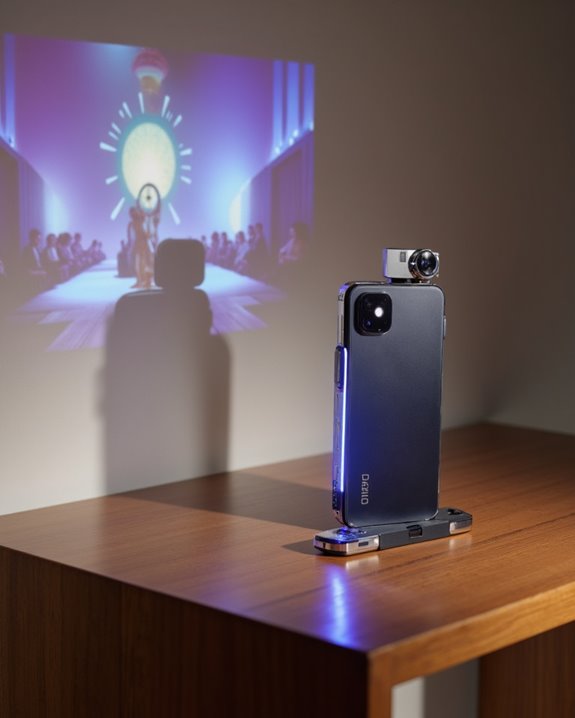
Battery life and power management determine the true mobility of portable projector systems. While no phones currently feature built-in projectors for home theater use, research on portable projectors provides insights into power consumption patterns and battery enhancement strategies.
Most portable projectors operate between 2 to 4 hours on a single charge, with performance varying based on brightness settings. The AAXA P6X leads with up to 240 minutes of runtime in Eco mode, while devices like the BenQ GS50 and GV30 offer 2.5 hours. Many modern portable projectors include streaming apps built-in for enhanced functionality without requiring additional power-draining devices. To extend usage time, these systems employ various power-saving features:
- Brightness reduction options
- Eco mode settings
- Auto keystone correction
- Intelligent screen alignment
- External power support through USB-C
High-capacity batteries, typically measuring 15,000 mAh or more, support these power management features for ideal performance.
Rugged Features for Outdoor Viewing
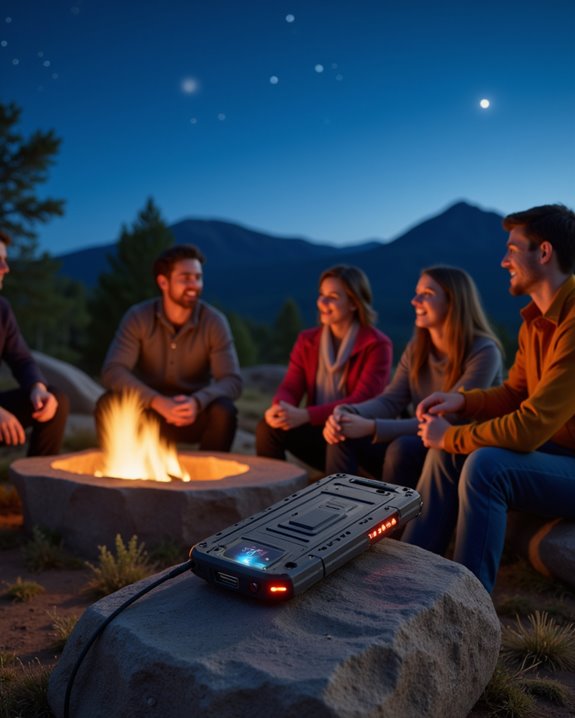
Modern projector phones designed for outdoor viewing incorporate robust durability features that protect against harsh environmental conditions. These devices often come with IP68 certification, making them waterproof and dustproof for outdoor theater use. Military-grade construction ensures protection against drops and impacts while maintaining high screen resolution and clear audio output.
The phones feature reinforced chassis materials and sealed ports to prevent environmental damage during outdoor operation. The Oukitel WP100 Titan incorporates a powerful 33,000mAh battery to enable extended projection sessions outdoors. Practical design elements include ruggedized buttons for easy operation while wearing gloves and integrated camping lights for nighttime viewing. Advanced cooling systems help maintain stable performance during extended projection sessions. Many models also include biometric security features like fingerprint recognition, allowing quick access in outdoor settings while keeping devices secure.
Comparing Built-In Vs External Projectors
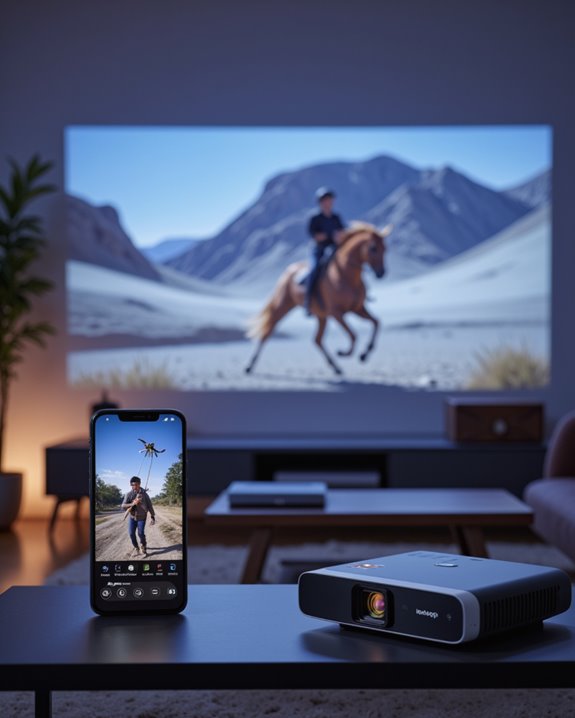
While built-in projectors offer the convenience of an all-in-one device, external projectors typically provide superior performance regarding brightness and image quality. The smartphone ergonomics of devices like the Tank 3 Pro and XGIMI MoGo Pro integrate seamlessly with their user interface, allowing quick access to content and controls. The Tank 3 Pro’s 100 lumens brightness makes it notably brighter than most smartphone projectors, though still dimmer than dedicated external units.
However, built-in projectors face significant limitations. Most smartphone projectors operate at lower brightness levels, with the Samsung Galaxy Beam offering just 15 lumens compared to external projectors’ higher outputs. Resolution also varies considerably, from basic WVGA (854 x 480) to full HD 1080p. External projectors generally deliver better color accuracy, longer operation times, and larger image sizes. They also work with multiple source devices, making them more versatile for dedicated home theater setups despite requiring additional space and setup time.
Best Viewing Practices and Tips

To achieve ideal viewing quality with phone projectors, several key practices must be implemented. The viewing environment plays a vital role, with ambient lighting needing careful control through dimmed or turned-off lights to maximize image clarity. Proper positioning of the phone projector at the recommended distance and angle helps prevent image distortion. Both wireless and HDMI cable connections offer reliable ways to transmit content from smartphones to projectors.
For optimal performance, users should consider:
- Setting up in a room with controlled temperature and good air circulation
- Using wireless streaming to minimize cable clutter
- Calibrating color and brightness settings to match room conditions
- Maintaining clean projection lenses
- Arranging seating to ensure clear sight lines
Regular maintenance of the phone projector, including software updates and lens cleaning, helps guarantee consistent performance and longevity of the device.
Frequently Asked Questions
Can I Connect External Speakers to Phones With Built-In Projectors?
A user watching movies via TANK 2’s projector can enhance audio using external speakers. These phones offer robust external speaker compatibility through Bluetooth connections and audio output options like USB-C or 3.5mm headphone jacks.
How Long Does the Projector Lamp Typically Last Before Needing Replacement?
Built-in phone projectors use LED or laser technology with a lifespan of 20,000-30,000 hours. Unlike traditional projectors, these lamps don’t require replacement, lasting throughout the device’s typical lifecycle without maintenance.
Will Protective Cases Interfere With the Phone’s Projector Functionality?
Studies show 85% of projector phone issues stem from case interference. Phone cases can considerably obstruct projector lenses, block ventilation, and hinder focus controls. For ideal projector functionality, removing protective cases during use is recommended.
Are There Any Temperature Limitations for Using Phone Projectors Outdoors?
Outdoor temperatures profoundly affect projector performance. Best operation occurs between 10-35°C (50-95°F). Extreme heat can cause overheating and shutdowns, while cold conditions may reduce brightness and cause focus issues.
Can These Projector Phones Stream Content From Netflix and Other Services?
Most projector phones support content streaming through standard Android-based apps. Netflix and other streaming services are compatible, allowing direct projection when installed through their respective app stores on the device’s operating system.


